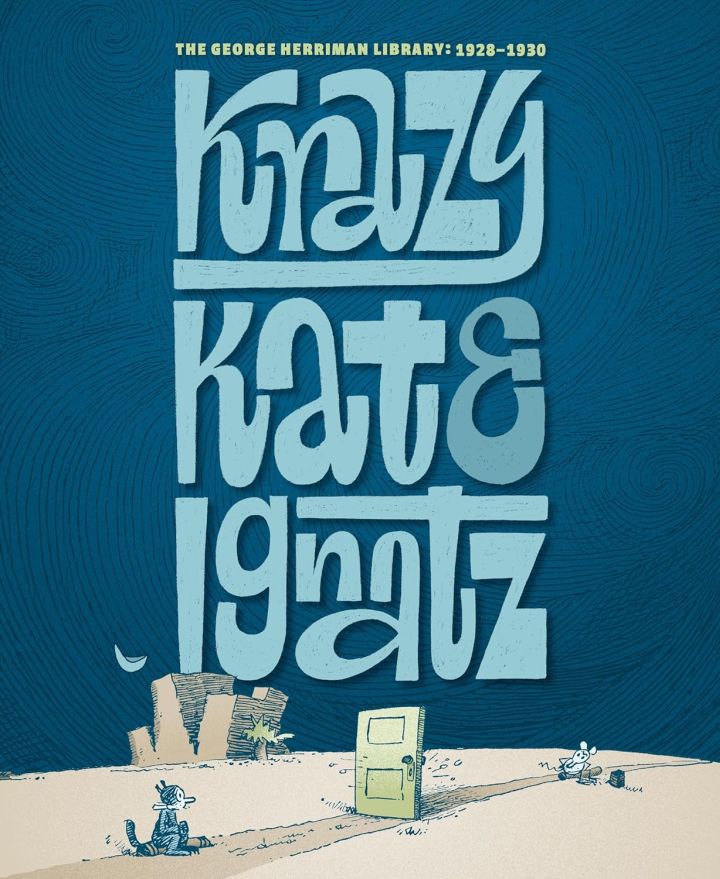
I do not receive a daily newspaper. Nor have I for over a decade. I used to pay attention to web comics… maybe three of them, but the ones I liked either radically wore out their welcome or became so inconsistent that their arrival was like a letter from a long-gone acquaintance. I have no idea if young people have any connection with the tradition of the morning comics page at all.
Buy The George Herriman Library: Krazy & Ignatz 1928-1930It’s one of the great original American art forms, the daily comic strip. When you’re a kid, it seemed the only reason to get a newspaper at all. And Krazy Kat, or Krazy & Ignatz, as it’s titled in this magnificent hardcover reprint by Fantagraphics, is widely regarded as one of the most interesting and artistically satisfying comic strips of the early 20th century.
The setup is simple: Krazy Kat loves Ignatz the mouse. Ignatz loves to throw a brick at Krazy Kat’s head. Krazy interprets the assault (erroneously) as a symbol of Ignatz returning his affection. Officer Pupp loves, in some way, Krazy. So, he is forever throwing Ignatz into jail for his brick-throwing, whether consummated, attempted, or just imagined. Krazy is always longing for Ignatz. Ignatz is always scheming to get a brick to throw. Pupp is always on the watch out.
From this simple, if daffy formula, author and illustrator George Herriman creates a multitude of clever scenarios. Set in a fictionalized Coconino County, Arizona, Herriman supplements his three main characters with a ring of strange supporting players. There’s a number of ducks, including the irritating busy body Mrs. Kwakk Wakk, and the Chinese laundry duck, Mock Duck. Occasionally the itinerant insect Bum Bill Bee wanders through town with his pot of honey and his constantly contradicting narration:
“Bum Bill Bee, slowly hastening to a rendezvous with nobody, heads north in his southerly course, with the rising sun gently setting before him.” It goes on much longer than that, but that’s a main attraction of the strip: Herriman’s constant language play. Everyone speaks in a patois. Krazy Kat’s most famous refrain is from his song: “There is a heppy land, fur, fur awaay.”
Sometimes it’s extreme to the point where you (or, more pointedly, I) have to sound out the strange spellings to try and get some clue as to what actual English words are being represented. Sometimes, I’ve been defeated by it, and can’t make heads or tails of what I’m reading. But the strip is even more inventive than that. It has sequences that are dreams that you can only tell from inference. There’s one strip that’s meant to be read backwards; the only indication of this is the final panel, with pointing fingers directing the reader “hither and yon.”
This collection contains the Sunday strips from 1928-1930. There wasn’t always new Sunday strips running every week, so it isn’t exactly, say, 156 strips. But the content is supplemented by several essays giving context to the work, including an influential essay from 1924 by journalist George Seldes. This helped solidify Krazy Kat‘s reputation as not just a charming set of illustrations, but as a genuine act of artistic expression.
I’ve written before about Krazy Kat a couple of times on Cinema Sentries, on the predecessor to this collection, and a rare daily collection that unfortunately is not likely to see a follow-up. I’ve written about Herriman’s wild attitude towards visual continuity (basically, every panel might be from a completely different place) and his language play.
This collection has a rare continuing Sunday story, from June to about September. A French cat moves to Coconino County and woos Krazy away from Ignatz. This causes the mouse and dog, Officer Pupp, to join forces, however briefly. But the joy of Krazy & Ignatz isn’t necessarily in the story, but the storytelling. Constantly reinventing the exact same thing, again and again and again, in surprising ways is one of the strip’s real pleasures.
The George Herriman Library: Krazy & Ignatz 1928-1930 is the fifth volume of the George Herriman Library published by Fantagraphics. Each hardcover volume contains the Sunday strips for several years, in a large form factor, 11.3 x 13.8 inches. It also contains several essays relating to the artist and the work, and other illustrations by Herriman. Krazy & Ignatz is so idiosyncratic (and so consistent) that it’s hard to say whether any single volume is a good jumping in point. There’s not an important continuity to worry about. It’s all so good (if you can get on its weird wavelength) that any collection is worth pursuing. So… get this one.